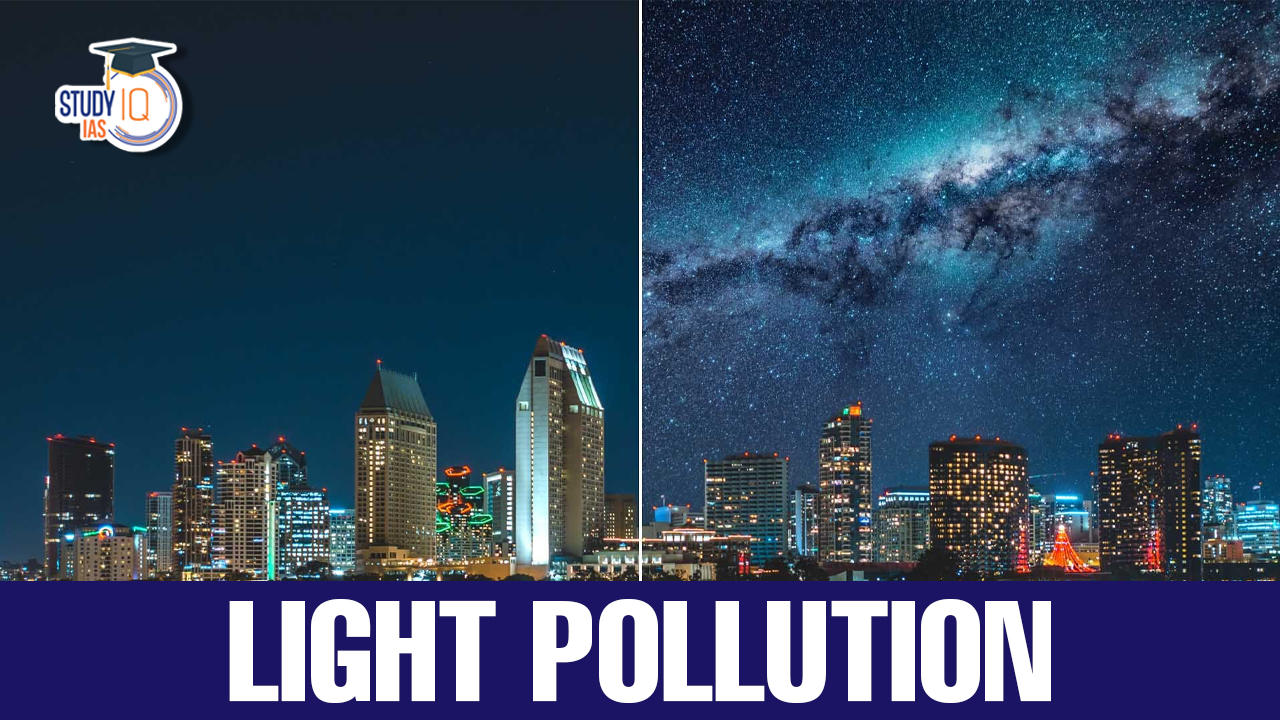Table of Contents
Context: Researchers are documenting the impact of light pollution on ecosystems, human health, and culture.
What is Light Pollution?
- It is the alteration of night natural lighting level caused by unwanted, inappropriate or excessive anthropogenic artificial sources of light. It’s a side effect of industrial civilization and urbanization.
- Its sources include building exterior and interior lighting, advertising, outdoor area lighting (such as car parks), offices, factories, street lights and illuminated sporting venues.
Types of Light Pollution

Stats IQ: Light pollution across globe and India
- According to the World Atlas on Night Sky Brightness, 83% of the world’s population lives under night-polluted skies.
- According to a study “Artificial night sky brightness and its impact on human health and environment in India” published in 2019, the brightness of India’s night skies has increased by around 20% over the past decade.
- The above also study found that around 70% of India’s population lives under light-polluted skies, and the problem is particularly acute in major cities like Mumbai, New Delhi, and Kolkata.
Impacts of Light Pollution
- Human health: An increased amount of light at night lowers melatonin production, which results in sleep deprivation, fatigue, headaches, stress, anxiety, and other health problems.
- Environmental impacts:
- Impact on nocturnal wildlife: Light pollution radically alters the night time environment by turning night into day, which will have negative impact on physiology, breeding patterns and mating behaviors of nocturnal animals.
- Disrupting ecosystems: Artificial light can disrupt the natural rhythms of wildlife, such as birds, insects, and sea turtles. This can make it difficult for them to navigate, feed, and reproduce, which can have a ripple effect on entire ecosystems.
- Disturbing migratory patterns: Birds, butterflies, and other animals rely on the stars and moonlight to navigate during migration. Artificial light can disorient and confuse these animals, making it difficult for them to reach their destination.
- Insect biodiversity loss: Artificial light alters the patterns of insect movement, foraging, reproduction and predation of insects resulting in the decline of insect population.
- Carbon footprint: In the U.S. alone, about 15 million tons of CO2 are emitted each year to power residential outdoor lighting that equals the emissions of about 3 million passenger cars and adds up to 40,000 tons per day.
- Economic impacts: Light pollution can have a significant impact on the economy by reducing visibility, hindering astronomical research, and diminishing the value of dark skies for tourism and recreation.
- Impacts on astronomical observations: Light pollution is one of the main factors that affect astronomical observations, which makes it difficult to see celestial objects from the ground.
- Energy consumption: Light pollution contributes to energy waste as much of the light is directed upwards and not towards the intended targets.
Global initiatives to curb Light Pollution
- The International Dark-Sky Association (IDA): The IDA is a non-profit organization that works to protect the night skies for present and future generations by advocating for responsible outdoor lighting and promoting dark sky places.
- The Globe at Night program: This program is an international citizen-science campaign to raise public awareness of the impact of light pollution.
- The International Year of Light and Light-based Technologies (IYL 2015): It was by the United Nations to raise awareness of the importance of light and optical technologies in our daily lives, and to encourage the responsible use of artificial light to reduce light pollution.
Way Forward
- Education and Awareness: Increasing the public awareness about the impacts of light pollution on the environment, human health, and astronomy is the need of the hour.
- Public Lighting Design: New lighting design principles should minimize light pollution. This includes directing light downward, sensor based on-off systems, and employing lighting fixtures with minimal light spill and glare.
- Individual Actions: There is a need to encourage individuals to take personal responsibility by using lighting judiciously. This includes turning off unnecessary outdoor lights, using motion sensor lights or timers, and choosing energy-efficient lighting options such as LED bulbs.
- International Cooperation: Foster international cooperation and exchange of best practices to address light pollution on a global scale. Encourage countries to adopt lighting standards and regulations that prioritize dark skies and minimize light pollution.





















 WhatsApp
WhatsApp